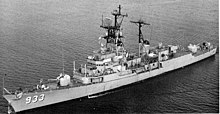USS Barry (DD-933)
 USS Barry (DD-933) |
|
| Overview | |
|---|---|
| Type | destroyer |
| Keel laying | March 15, 1954 |
| Launch | October 1, 1955 |
| 1. Period of service |
|
| period of service |
July 9, 1956 - |
| Whereabouts | Pending scrapping |
| Technical specifications | |
| displacement |
4,050 tons |
| length |
127.50 meters |
| width |
13.80 meters |
| Draft |
6.7 meters |
| crew |
314 |
| drive |
Two steam turbines, 70,000 hp, two screws |
The USS Barry (DD-933) was a destroyer of the Forrest Sherman-class destroyer of the United States Navy . She is the third ship named after John Barry . As a result of renovations in the mid-1960s, she became the type ship of the Barry class .
history
Construction and commissioning
The construction contract for the Barry was issued on December 15, 1952, the keel was laid on March 15 at Bath Iron Works in Bath , Maine . The launch took place after the baptism by Mrs. Francis Rogers, a great-great-niece of the namesake, on October 1, 1955. On September 7, 1956 it was put into service with the Navy.
period of service
The Barry was assigned to the Atlantic Fleet and initially operated in the Caribbean and off Central America , was then transferred to the Mediterranean in 1957, where it operated as part of the 6th Fleet in the carrier combat groups of various aircraft carriers. On September 26, she escorted the Seawolf submarine as it was doing diving exercises with President Eisenhower on board off Newport. After further exercises off the US coast, the destroyer returned to the Mediterranean, where it operated with the 6th Fleet. After the July 14 coup in Iraq , Lebanese President Camille Chamoun asked for American support. The aircraft carrier Saratoga , to whose combat group the Barry belonged at the time, was moved off the coast of Lebanon to support Marines who were supposed to stabilize the situation on land. In the summer of 1960, the ship visited Kiel and other European port cities during an extensive European voyage and undertook large-scale exercises together with European naval ships. During the following mission in the Mediterranean, the destroyer, as part of the escort ships of the USS Randolph, shadowed Soviet ships that were leaving the Black Sea for Cuba . During the sea blockade of Cuba in October 1962, the ship was assigned as a guard on the quarantine line, chasing a Soviet Foxtrot-class diesel submarine, among other things, and monitoring the search of several merchant ships whose destination was Cuba. In the following years the Barry operated again in the Caribbean and the Atlantic as well as in the Mediterranean, took part in the recovery of the Gemini 4 capsule and was then relocated to the Pacific, where it operated for a year off the coast of Vietnam and American from 1965 Units supported.
After completing her circumnavigation in 1966, the Barry went into dry dock in Boston on July 23 , where extensive renovation work was due for the first time. The Barry received a new radar and sonar system, which was extensively tested after undocking. She returned to dock on January 4, 1967 and was formally decommissioned on January 31. In the following 15 months, the ship was completely rebuilt, received, among other things, an ASROC starter in place of the second gun and was then put back into service in April 1968 as the lead ship of the new Barry class. The first operations then took place in the Mediterranean, off the Greek coast. The new home port of the Barry was Athens , where she was stationed as part of the Forward Deployment Program . Until the end of the 1970s, the destroyer mostly operated in the eastern Mediterranean, and in 1978 visited northern and central Europe again, including Bremen and Amsterdam . After a visit to Kenya and a final passage through the Mediterranean Sea and crossing the Atlantic, the destroyer was decommissioned on November 5, 1982 and towed to Philadelphia .
Whereabouts
After its decommissioning, the ship was towed to Washington, DC by the deep-sea tug Apache in the fall of 1983 . It has since been a museum ship ( 38 ° 52 ′ 15.6 ″ N , 76 ° 59 ′ 45.6 ″ W ) in the Washington Navy Yard on the Anacostia River as a visitor attraction. In 1990 the Barry was added to the National Register of Historic Places . After the upcoming renovation costs of around two million US dollars were considered too high in view of the low number of visitors, the Barry was adopted as a museum ship on October 17, 2015 and towed to the Philadelphia Naval Shipyard for scrapping in May 2016 .
Web links
Individual evidence
- ^ National Register of Historic Places , as of June 1, 2007
- ↑ navy.mil: Navy Bids Farewell to Display Ship Barry, 10/17/2015 , as of November 26, 2016
- ↑ wtop.com: Museum ship at Navy Yard leaving the nation's capital, 5/6/2016 , as of November 26, 2016
